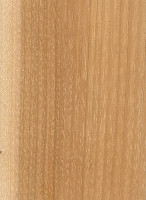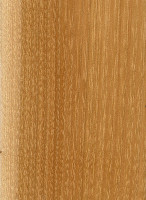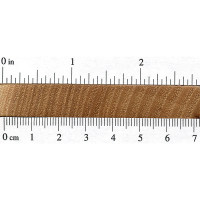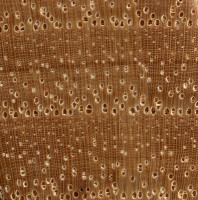 |
Common Name(s): Pignut Hickory Scientific Name: Carya glabra Distribution: Eastern United States Tree Size: 65-100 ft (20-30 m) tall, 2-3 ft (.6-1.0 m) trunk diameter Average Dried Weight: 52 lbs/ft3 (835 kg/m3) Specific Gravity (Basic, 12% MC): .66, .83 Janka Hardness: 2,140 lbf (9,520 N) Modulus of Rupture: 20,100 lbf/in2 (138.6 MPa) Elastic Modulus: 2,260,000 lbf/in2 (15.59 GPa) Crushing Strength: 9,190 lbf/in2 (63.4 MPa) Shrinkage: Radial: 7.2%, Tangential: 11.5%, Volumetric: 17.9%, T/R Ratio: 1.6 |
Color/Appearance: Heartwood tends to be light to medium brown, with a reddish hue; sapwood is a paler yellowish brown. Boards with contrasting heartwood and sapwood create a somewhat rustic appearance that’s sometimes marketed as Calico Hickory.
Grain/Texture: Grain is usually straight, though occasionally wavy, with a medium texture. Pores are medium-sized and open.
Rot Resistance: Considered to be non-durable to perishable regarding heartwood decay, and also very susceptible to insect attack.
Workability: Difficult to work, with tearout being common during machining operations if cutting edges are not kept sharp; the wood tends to blunt cutting edges. Glues, stains, and finishes well. Responds well to steam bending.
Odor: No characteristic odor.
Allergies/Toxicity: Besides the standard health risks associated with any type of wood dust, no further health reactions have been associated with Pignut Hickory. See the articles Wood Allergies and Toxicity and Wood Dust Safety for more information.
Pricing/Availability: Various species of Hickory and Pecan (Carya genus) are typically mixed together and simply sold as Hickory. Prices are usually in the low to mid range, depending upon local availability. Hickory prices should compare similarly to other utility hardwoods such as Red Oak or Soft Maple.
Sustainability: This wood species is not listed in the CITES Appendices or on the IUCN Red List of Threatened Species.
Common Uses: Tool handles, ladder rungs, wheel spokes, flooring, etc.
Comments: Hickory is among the hardest and strongest of woods native to the United States. On average, Hickory is denser, stiffer, and harder than either White Oak or Hard Maple. The wood is commonly used where strength or shock-resistance is important.
Pignut Hickory falls into the True-Hickory grouping, and is considered to be a ring-porous wood. The strength characteristics of Hickory are influenced considerably by the spacing of its growth rings. In general, wood from faster-growing trees, with wider spaced growth rings, tends to be harder, heavier, and stronger than wood from slower-growing trees that have rings which are closer together.
In addition to strength and hardness applications, the wood of Carya species also has a very high thermal energy content when burned, and is sometimes used as fuelwood for wood stoves. Additionally, Hickory is also used as charcoal in cooking meat, with the smoke imparting additional flavor to the food.








This wood is excellent for a nunchaku.
What about wood for a spear shaft? So far I’ve got ash, pignut hickory, and shagbark hickory. Marcusrandall and kal890, you said shagbark for training swords. Anybody got thoughts on it?
You say fast growth is harder and stronger than slow growth wood? Isn’t it the other way around, or is hickory unique in that respect? “wood from faster-growing trees, with wider spaced growth rings, tends to be harder, heavier, and stronger than wood from slower-growing trees that have rings which are closer together.”
You are right in that, generally, slower grown trees tend to produce harder and stronger wood. A notable exception is with most ring-porous woods (such as hickory) where the slower it tends to grow, the more volume of the wood is taken up by rows of very light (and weak) earlywood pores. For reference, the lightest piece of oak (also a ring-porous hardwood) that I’ve ever come across was from a tree that grew very slow, and nearly the entire piece was made up of just big, airy earlywood pores.
This here Pignut as well as Shagbark are the world’s best woods for the application of wooden training weapons like bokkens. Thought I’d put it here if someone were looking for a wood for such application.
as a matter of fact, shagbark hickory has the highest crushing and bending strength, while pignut is too dense and too hard, making it more breakable in paired sword practice, so I’d go with shagbark first.
cheers
Any ideas on spear shafts?